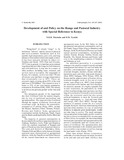| dc.description.abstract | Rangeland” or simply “range” is, by definition, “inferior” land by reason of physical and socio-economic limitations such as low rainfall, high temperatures, poor soils, and long distances from market outlets and supply centres. It has been variously defined by others (cf. Stoddart and Smith, 1955; Pratt and Gwynne, 1977); but, in general, it is land that carries natural vegetation that provides forage for both domestic and wild herbivores. It may also be a source of other products, including water, minerals, and services such as recreation. The rangelands of Kenya, for example, receive less than 750 mm of rain per year and have average temperatures that occasionally rise to 40°C. These are extensive lands covering about 85% of the total land area of 583,000km2. This expansive area is home to 25% of the total human population, estimated at 29 million (GOK, 1999). The density is as low as two persons per km2 in the very arid parts | en_US |

